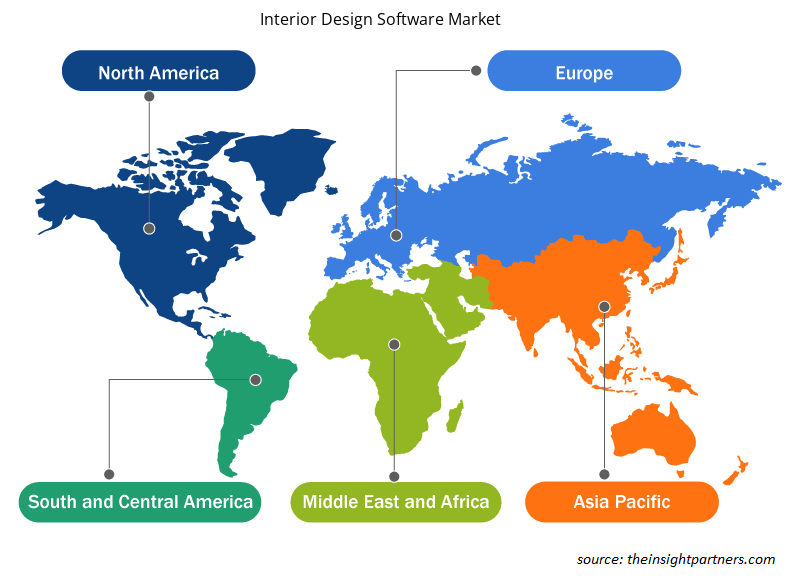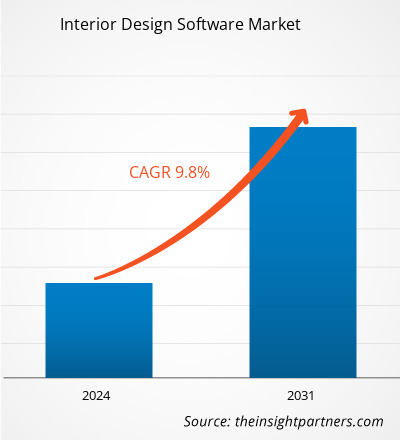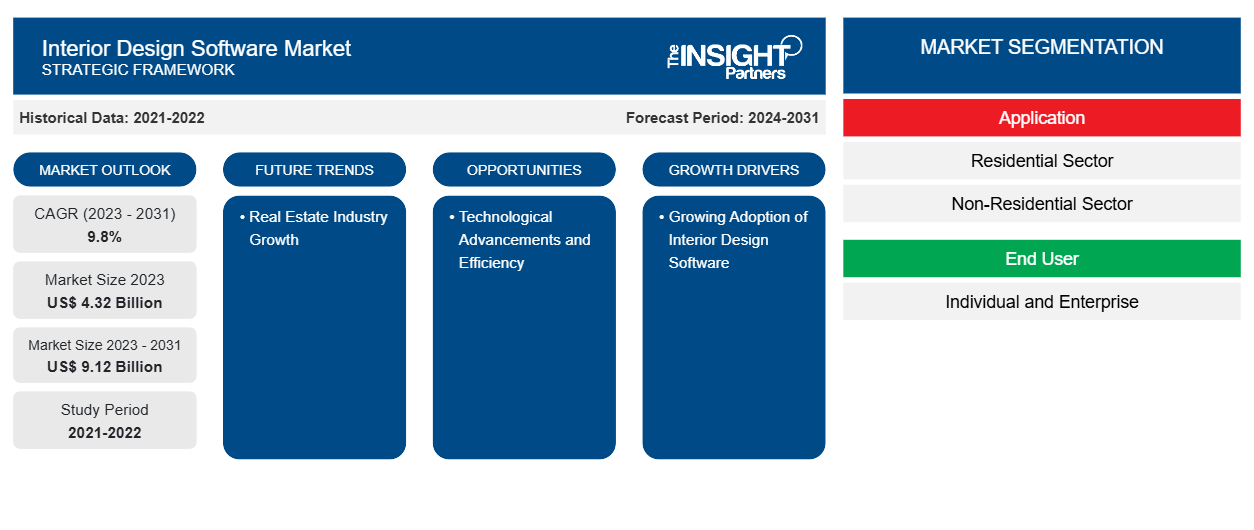Se prevé que el tamaño del mercado de software de diseño de interiores alcance los 9.120 millones de dólares en 2031, frente a los 4.320 millones de dólares en 2023. Se espera que el mercado registre una CAGR del 9,8 % durante el período 2023-2031. Es probable que el crecimiento de la industria inmobiliaria siga siendo una tendencia clave en el mercado.
Análisis del mercado de software de diseño de interiores
La creciente demanda de mayor productividad es uno de los principales factores que impulsan este mercado. Además, la creciente demanda de un mejor diseño y decoración de interiores y el creciente uso de software basado en la nube impulsan el crecimiento del mercado. Los problemas de interoperabilidad asociados con el software de diseño de interiores limitan el crecimiento de este mercado. Además, se espera que el crecimiento del proceso de virtualización y la demanda de software de diseño de interiores, que está creciendo a un ritmo rápido en países como China, brinden múltiples oportunidades al mercado.
Descripción general del mercado de software de diseño de interiores
El software de diseño de interiores permite a los arquitectos realizar una estimación temprana de la calidad del ambiente interior. Los arquitectos también pueden utilizar este software para identificar, rastrear y medir cualquier desviación del edificio diseñado con respecto a los criterios requeridos. Este software también permite a los arquitectos tomar medidas preventivas para reducir la necesidad de renovación y reconstrucción. También cuenta con una colección completa de opciones, como diseños de ventanas , puertas, camas y mesas, que un diseñador puede utilizar para hacer un modelo exacto de la habitación.
Personalice este informe según sus necesidades
Obtendrá personalización en cualquier informe, sin cargo, incluidas partes de este informe o análisis a nivel de país, paquete de datos de Excel, así como también grandes ofertas y descuentos para empresas emergentes y universidades.
-
Obtenga las principales tendencias clave del mercado de este informe.Esta muestra GRATUITA incluirá análisis de datos, desde tendencias del mercado hasta estimaciones y pronósticos.
Factores impulsores y oportunidades del mercado del software de diseño de interiores
Creciente adopción de software de diseño de interiores
Un factor clave del crecimiento del mercado de software de diseño de interiores es el uso cada vez mayor de este tipo de software por parte de arquitectos, ingenieros y contratistas. Contribuyó significativamente durante las primeras etapas de diseño para evaluar los interiores. Reduce los errores, permite una gestión eficaz del tiempo y muestra las diferencias entre un diseño propuesto y la construcción real, mejorando la eficiencia y la precisión generales en su trabajo al configurar los planos de planta, los muebles y las decoraciones interiores en un entorno tridimensional realista.
Avances tecnológicos y eficiencia
El aumento repentino de las actividades de construcción a nivel mundial, que se produjo simultáneamente con la adopción generalizada de software de diseño de interiores para mejorar la eficiencia operativa, acelera enormemente el crecimiento en el sector de servicios de diseño de interiores. Esta tendencia se ve reforzada por la capacidad de este software para acelerar el proceso de diseño, ahorrar tiempo y costos y ofrecer una amplia colección de opciones de muebles que permiten a los diseñadores realizar modelos de habitaciones precisos y realistas. Por lo tanto, la creciente integración del software de diseño de interiores no solo facilita las operaciones, sino que también contribuye al crecimiento absoluto del mercado.
Análisis de segmentación del informe de mercado de software de diseño de interiores
Los segmentos clave que contribuyeron a la derivación del análisis del mercado de software de diseño de interiores son la aplicación y los usuarios finales.
- Según la aplicación, el mercado se divide en el sector residencial y el sector no residencial. El segmento del sector residencial tuvo una participación de mercado significativa en 2023.
- En función de los usuarios finales, el mercado se segmenta en particulares y empresas. El segmento empresarial tuvo una participación de mercado significativa en 2023.
Análisis de la cuota de mercado del software de diseño de interiores por geografía
El alcance geográfico del informe de mercado de software de diseño de interiores se divide principalmente en cinco regiones: América del Norte, Asia Pacífico, Europa, Medio Oriente y África, y América del Sur y Central.
El panorama regional del mercado de software de diseño de interiores revela importantes oportunidades de crecimiento en varias regiones. En Asia-Pacífico, el aumento de la población y la urbanización, en particular en las principales ciudades como Tokio, Pekín y Bombay, ha llevado a un mayor enfoque en los sectores residenciales, con iniciativas como la estrategia nacional de desarrollo de China que apuntan a una urbanización sustancial. Además, se proyecta que Asia-Pacífico registre la CAGR más alta del mercado durante el período de pronóstico, atribuida al aumento de los planes de infraestructura de construcción en países como China e India, así como a la creciente urbanización y expansión de la población en las principales ciudades como Pekín, Tokio y Bombay.CAGR in the market during the forecast period, attributed to increasing
Perspectivas regionales del mercado de software de diseño de interiores
Los analistas de Insight Partners explicaron en detalle las tendencias y los factores regionales que influyen en el mercado de software de diseño de interiores durante el período de pronóstico. Esta sección también analiza los segmentos y la geografía del mercado de software de diseño de interiores en América del Norte, Europa, Asia Pacífico, Oriente Medio y África, y América del Sur y Central.

- Obtenga datos regionales específicos para el mercado de software de diseño de interiores
Alcance del informe de mercado de software de diseño de interiores
| Atributo del informe | Detalles |
|---|---|
| Tamaño del mercado en 2023 | US$ 4.32 mil millones |
| Tamaño del mercado en 2031 | US$ 9,12 mil millones |
| CAGR global (2023 - 2031) | 9,8% |
| Datos históricos | 2021-2022 |
| Período de pronóstico | 2024-2031 |
| Segmentos cubiertos |
Por aplicación
|
| Regiones y países cubiertos |
América del norte
|
| Líderes del mercado y perfiles de empresas clave |
|
Densidad de actores del mercado de software de diseño de interiores: comprensión de su impacto en la dinámica empresarial
El mercado de software de diseño de interiores está creciendo rápidamente, impulsado por la creciente demanda de los usuarios finales debido a factores como la evolución de las preferencias de los consumidores, los avances tecnológicos y una mayor conciencia de los beneficios del producto. A medida que aumenta la demanda, las empresas amplían sus ofertas, innovan para satisfacer las necesidades de los consumidores y aprovechan las tendencias emergentes, lo que impulsa aún más el crecimiento del mercado.
La densidad de actores del mercado se refiere a la distribución de las empresas o firmas que operan dentro de un mercado o industria en particular. Indica cuántos competidores (actores del mercado) están presentes en un espacio de mercado determinado en relación con su tamaño o valor total de mercado.
Las principales empresas que operan en el mercado de software de diseño de interiores son:
- Autodesk Inc.
- Arquitecto Jefe, Inc.
- Dassault Sistemas
- ECDESIGN Suecia AB
- Sketcher de habitación AS
- Roomtodo OU
Descargo de responsabilidad : Las empresas enumeradas anteriormente no están clasificadas en ningún orden particular.

- Obtenga una descripción general de los principales actores clave del mercado de software de diseño de interiores
Noticias y desarrollos recientes del mercado de software de diseño de interiores
El mercado de software de diseño de interiores se evalúa mediante la recopilación de datos cualitativos y cuantitativos a partir de una investigación primaria y secundaria, que incluye publicaciones corporativas importantes, datos de asociaciones y bases de datos. A continuación, se enumeran algunos de los avances en el mercado de software de diseño de interiores:
- IKEA US anunció el lanzamiento de IKEA Interior Design Service, un nuevo programa que ofrece diseño de interiores profesional personalizado a un precio asequible. Los consumidores y las empresas tendrán la oportunidad de conectarse con un experto para diseñar cualquier espacio con soluciones creativas.
(Fuente: Inter IKEA Systems BV, sitio web de la empresa, abril de 2023)
- Ingka Group, el mayor minorista de IKEA, lanza hoy su nueva experiencia de diseño digital impulsada por IA, IKEA Kreativ. La nueva experiencia intuitiva ofrece a los clientes la primera forma realista y totalmente integrada de diseñar y visualizar sus propios espacios vitales desde computadoras y teléfonos inteligentes.
(Fuente: Inter IKEA Systems BV, sitio web de la empresa, julio de 2022)
Informe de mercado sobre software de diseño de interiores: cobertura y resultados
El informe “Tamaño y pronóstico del mercado de software de diseño de interiores (2021-2031)” proporciona un análisis detallado del mercado que cubre las siguientes áreas:
- Tamaño del mercado de software de diseño de interiores y pronóstico a nivel global, regional y nacional para todos los segmentos clave del mercado cubiertos bajo el alcance
- Tendencias del mercado de software de diseño de interiores, así como dinámicas del mercado, como impulsores, restricciones y oportunidades clave
- Análisis detallado de las cinco fuerzas de Porter y PEST y FODA
- Análisis del mercado de software de diseño de interiores que cubre las tendencias clave del mercado, el marco global y regional, los principales actores, las regulaciones y los desarrollos recientes del mercado.
- Panorama de la industria y análisis de la competencia que abarca la concentración del mercado, análisis de mapas de calor, actores destacados y desarrollos recientes en el mercado de software de diseño de interiores
- Perfiles detallados de empresas
- Análisis histórico (2 años), año base, pronóstico (7 años) con CAGR
- Análisis PEST y FODA
- Tamaño del mercado, valor/volumen: global, regional y nacional
- Industria y panorama competitivo
- Conjunto de datos de Excel
Informes recientes
Informes relacionados
Testimonios
Razón para comprar
- Toma de decisiones informada
- Comprensión de la dinámica del mercado
- Análisis competitivo
- Información sobre clientes
- Pronósticos del mercado
- Mitigación de riesgos
- Planificación estratégica
- Justificación de la inversión
- Identificación de mercados emergentes
- Mejora de las estrategias de marketing
- Impulso de la eficiencia operativa
- Alineación con las tendencias regulatorias























 Obtenga una muestra gratuita para - Mercado de software de diseño de interiores
Obtenga una muestra gratuita para - Mercado de software de diseño de interiores